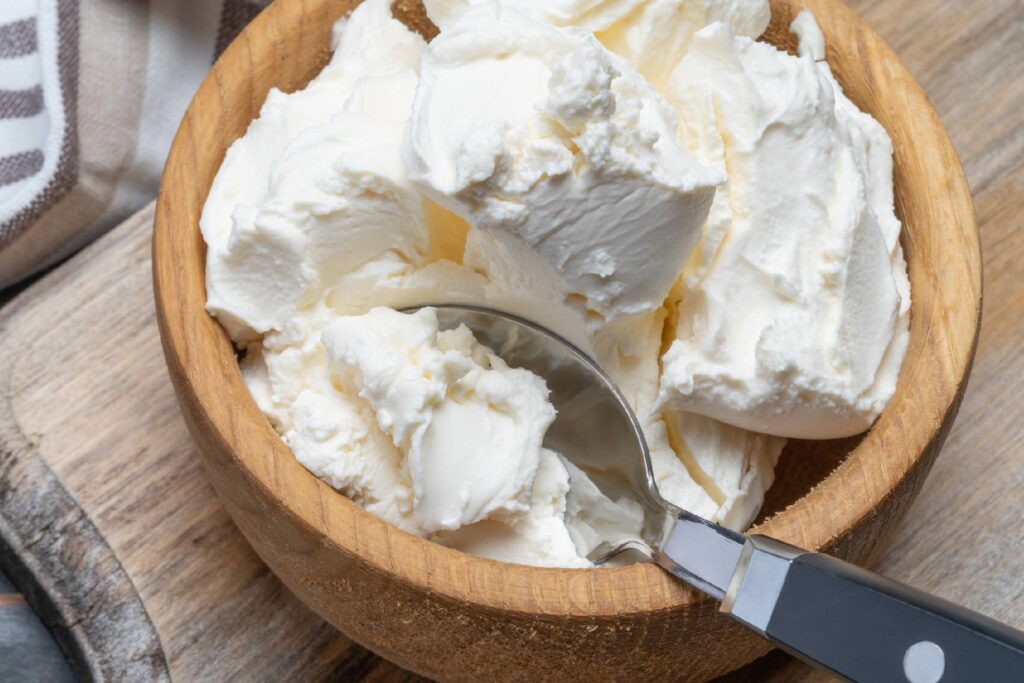Embodying the rich culinary heritage of Italy is the succulent Mascarpone cheese. Rivaled by few in its class, Mascarpone offers a slew of taste profiles and an impressive versatility. To the novice gastronome, Mascarpone maybe just another type of cheese, but its production process, taste and usage reveal a more interesting story that is worth delving into.
Originating from the Lombardy region of Northern Italy during the late 16th or early 17th century, Mascarpone is a coagulated cream, often described as a cheese due to its creamy, thick texture. Depending on its maturation, Mascarpone can range from buttery and sweet to sharp and tangy, accommodating various palettes and culinary needs. Despite its richness, Mascarpone has a softer texture than most cheeses. It’s made by curdling cream with citric acid, vinegar or lemon juice, which brings forth its unique, delicately creamy-gentle profile.
Distinctive to Mascarpone is its versatility. Unlike many other cheeses, it can be effortlessly incorporated into both sweet and savory dishes, resulting in an intriguing depth of flavor. Some popular uses include:
- Tiramisu: Mascarpone serves as the principle ingredient in this world-renowned Italian dessert.
- Stuffed pasta: In this savory dish, creamy Mascarpone offers a distinct counterbalance to the robust flavors of the pasta and vegetables.
- Fruit topping: The slightly sweet flavor profile makes Mascarpone a delightful addition to fruit for a simple dessert.
The quality of Mascarpone cheese can be gauged by its appearance and texture. It should have a pale creamy color with no signs of yellowing, which might indicate over-fermentation. In terms of texture, it should be smooth, creamy, spreadable and lack any lumps or grains. The most appealing Mascarpone cheese should effortlessly melt in the mouth, releasing its subtly sweet and mild flavors. In every dimension, Mascarpone is a staple for those who appreciate the refined fusion of tradition and taste in the world of cheese.
Welcome to our quiz on the topic of ‘Mascarpone Cheese’! Discover how well you understand this creamy cheese, its origins and uses in various cuisines. This is your chance to learn something different and unique. Ready to test your food knowledge? Start now!
Mascarpone cheese, born in the Lombardy region of Northern Italy, is a key distinguishing feature in many delightful gourmet foods such as Tiramisu, Risotto, and many others. Its delectable creamy texture, purity of color and mild sweetness have won the hearts of food lovers worldwide. However, just as any other cheese type, the quality of Mascarpone significantly impacts the culinary experience. To truly savor the rich, milky flavor of Mascarpone cheese, it’s important to know what indicates its quality and authenticity.
Mascarpone, vastly differs from most cheeses, because it is technically not cheese, but a derivative of cream manipulated in such a way to transition into a semisolid state. Its production involves heating up cream before introducing citric or tartaric acid to thicken it. It’s this process that gives Mascarpone its unique creamy texture and mild, slightly sweet flavor. A quality Mascarpone will leave a light, pleasing aftertaste of freshness, absent in inferior brands.
The first sign of high-quality Mascarpone is its texture – it should be smooth and creamy, almost spreadable, with a consistency comparable to that of custard or thick cream. The color is equally important. Premium Mascarpone boasts a lustrous, uniform ivory color, with no discoloration or unnatural hues. It’s also free from any lumps, grittiness, or signs of separation, which can indicate poor quality or mishandling.
When it comes to taste, Mascarpone resides on the subtle end of the cheese flavor spectrum. A top-quality Mascarpone cheese is distinguished by its mild buttery flavor with a slightly sweet taste. It should never taste sour or too tangy – qualities indicative of poor quality or an inauthentic product. Additionally, a quality Mascarpone:
- Should melt easily with a velvety mouthfeel.
- Maintains its structure when at room temperature.
- Does not separate or become oily when heated slowly.
Ultimately, it’s the delicate balance between Mascarpone’s distinctive creamy texture and subtle, yet intricate, flavor that makes it a standout addition to any gourmet kitchen. Thus, by recognizing these quality components, you can ensure that your culinary creations are always a star-studded gourmet affair.
Derived from the Lombardy region of Italy, mascarpone is a cream cheese that has garnered international appeal due to its superior quality and versatility. The signature ingredients of mascarpone include fresh cream and citric or tartaric acid, which are instrumental to its distinctive, velvety texture and slightly sweet flavor. Modern versions may also incorporate some permissible additives to stabilize product quality. However, traditional Mascarpone, appreciated by purists worldwide, sticks to the initial two key ingredients.

From a scientific perspective, mascarpone contains approximately 50% milk fat, contributing to its creamy and indulgent mouthfeel. It exhibits impressive thickening properties, due to the presence of proteins in the fresh cream that coagulate under the influence of the acidic substances. Alongside, carbohydrates and traces of sodium contribute to its taste balance. Given its inherent richness, mascarpone forms the perfect backdrop for both sweet and savory preparations, be it the classic Italian tiramisu or being a base for dips and sauces. Furthermore, mascarpone is a valuable source of vitamin A and minerals such as calcium and phosphorus, thus adding to its gastronomic value.
When it comes to artisanal mascarpone, variety is present in both texture and flavor nuances. Here are some of them:
- Vacche Rosse: Prepared from the milk of the selective breed of Reggiana cows, this mascarpone has a naturally sweeter profile.
- Buffalo Milk Mascarpone: This variety, sourced from buffalo milk, exhibits a thicker consistency and a more substantial, nuttier tang compared to its counterparts.
- Goat Milk Mascarpone: This is an ideal choice for those appreciating a tangier edge. It is lighter on the palate, yet still delivers on creaminess.
By understanding the ingredients, properties, and varieties of mascarpone, you can explore its delightful potential in your culinary adventures, validating why this Italian original is treasured as a top-quality cheese worldwide.
- Hailing from: Mascarpone cheese is an Italian invention, originating in the Lombardy region.
- Culinary uses: Mascarpone is a versatile cheese, frequently used in sweet and savoury dishes alike.
- Fat Content: Mascarpone cheese is considered a cream cheese and typically contains between 60% and 75% milk fat.
- Famous desserts: This cheese is a major ingredient in the famous Italian dessert, Tiramisu.
- Production process: Mascarpone is produced by acidifying the cream of cow’s milk, generally using citric acid or lemon juice.
- Texture: Mascarpone cheese has a thick, creamy texture, making it ideal for use in desserts.
- Substitutes: Despite its unique flavour and texture, in a pinch, cream cheese, crème fraiche, or ricotta can be used as substitutes for mascarpone cheese.
Originating from Italy, Mascarpone is a delectable, velvety cream cheese that enjoys a privileged spot at Italian dinner tables. Its rich and creamy character is associated with the Lombardy region in Northern Italy, where Mascarpone first appeared as early as the 16th century. Known for its dairy farming and rich, creamy milk products, Lombardy’s cuisine is abundant in flavor and tradition, and Mascarpone is no exception.
The cheese is produced in a unique method, involving tartaric acid or citric acid causing denaturation of proteins in cream. It is believed that the Mascarpone was first invented inadvertently by farmers, who were simply trying to preserve the surplus cream from milk production. Over time, they discovered that adding these ingredients (tartaric acid, citric acid) during the cream preservation process could lead to the production of a thick, creamy, and smooth cheese. The name ‘Mascarpone’ is derived from ‘mascarpia,’ the local Lombardian term for cream cheese.
Although Mascarpone does not enjoy the Protected Designation of Origin (PDO) status, unlike many other Italian cheeses, it is still protected under the Traditional Speciality Guaranteed (TSG) status. The TSG ensures that Mascarpone is crafted using the traditional Italian regional recipe and safeguards its authenticity and quality. Some crucial specifications include:
- Use of cream derived from cow milk without addition of flavorings or preservatives
- Production methods involving coagulation with suitable acidity
- Pasteurization of the cream to ensure health safety
The distinctive heritage and geographical ties of Mascarpone create an irresistible treat that offers a melt-in-your-mouth joyride. Whether it’s lending richness to a tiramisu, adding a creamy touch to savory pasta, or enhancing the taste of a simple cake, Mascarpone’s versatility makes it a favorite choice among cheese lovers keen to explore various flavors and culinary traditions.
The world of cheese is vast and exciting, with different varieties promising a new adventure of taste and texture. Today, we journey to the heart of Italy and delve into the delightful realm of Mascarpone. This Italian cream cheese, known for its thick consistency and velvety texture, offers a taste that’s both fresh and milky, with a hint of sweetness. It’s remarkably creamy, making it ideal for a variety of culinary uses.
Mascarpone truly shines when served with fresh fruit or used as a filling in desserts. Its mildly sweet profile wonderfully counters the tanginess and acidity in fruits, offering a balanced and luscious flavor experience. Imagine thick dollops of this cream cheese on top of fresh strawberries or peaches, or coating luscious figs – heaven in every bite. As a dessert ingredient, Mascarpone is a staple in Italy’s Tiramisu. The creamy texture and mild sweetness perfectly complement the coffee and cocoa flavors in this classic dessert. It’s also an excellent addition to cheesecakes, imparting a unique and delightful twist to the much-loved dessert.
Yet, the use of Mascarpone is not confined to the realm of sweets. It can add creaminess and depth when stirred into risottos or pasta sauces. Imagine the earthy flavors of a mushroom risotto being elevated by a dollop of Mascarpone added towards the end of the cooking process. Even in simple dishes like carbonara, the addition of Mascarpone instead of the traditional heavy cream will yield a richer, creamier result.
- Fruit topping: Mascarpone shines the brightest when served with fresh fruits like strawberries, peaches, and figs.
- Dessert ingredient: It’s a celebrated staple in classics like Tiramisu and can be an excellent addition in cheesecakes and pastries.
- Savory sauce upgrade: A dollop of Mascarpone can bring creamy depth to risottos, pastas, and other savory dishes.
So, delve into the world of Mascarpone, a versatile cheese that can enhance your culinary journey, whether you are crafting a sweet masterpiece or cooking up a savory extravaganza.
Mascarpone, a rich and creamy cheese originating from Italy, is a key ingredient in many recipes ranging from the beloved Tiramisu to savory pasta sauces. Made from thickened cream and citric acid, its slightly sweet and intensely creamy flavor has made it increasingly popular among gourmets worldwide. However, due to its delicate nature, knowing how to properly store mascarpone is crucial to maintaining its quality, taste and texture.
Firstly, mascarpone must always be kept refrigerated. This is due to its high dairy content and the fact that it does not contain any preservatives. In fact, it begins to decline in quality as soon as it is exposed to temperatures above 40°F (4°C). For freshness, store the cheese in the lowest part of your fridge, where it is coldest. The recommended temperature for storing dairy products is between 34 and 38 degrees Fahrenheit (1-3 degrees Celsius).
You might ask, what if you bought mascarpone in bulk and can’t use it all before it begins to spoil? The good news is that this cheese, like many other kinds, can be stored in the freezer. It can be kept frozen for up to two months while retaining much of its original flavor and texture. Be sure to pack it tightly in an airtight container or heavy-duty freezer bag to prevent freezer burn. Also, it’s important to remember that once mascarpone has been defrosted, it should be used immediately and never re-frozen.
Lastly, it is critical to always keep mascarpone sealed to avoid exposure to air. Once opened, mascarpone spoils quickly, within a week. As a rule of thumb, if the cheese smells sour or has mold growing on it, it’s time to say goodbye. By respecting these storage guidelines, you will be able to savor the luscious, slightly sweet and delightfully creamy flavors of mascarpone at their prime.
The creamy and indulgent flavor profile of Mascarpone cheese is revered among cheese enthusiasts and food lovers alike. Originating from Italy, this cheese exhibits a rich, buttery taste with a velvety, soft texture that melts in your mouth. While phenomenal on its own, Mascarpone truly shines when paired thoughtfully with wine. In this intricate dance of gastronomy, it is important to understand the symbiosis between these two entities.
When pairing cheese and wine, there are a few key principles to remember: it’s all about striking a balance, complementing flavors, and sometimes, boldly contrasting them to bring out unexpected nuances. Mascarpone, with its smooth, creamy texture and mild, subtly sweet taste, calls for wines that underscore these qualities without overwhelming them.
As a rule of thumb, sweet dessert wines serve as a splendid match for Mascarpone. The classic choice for many gourmets will be a sweet and fruity Moscato d’Asti. This wine, with its light, effervescent characteristics, perfectly complements the cheese’s richness, while its honey-like sweetness resonates beautifully with the mild, lactic flavors of Mascarpone.
Dessert wines like Sauternes or sweet Rieslings are also stellar taste partners. The concentrated, honeyed sweetness of these wines not only balances the rich decadence of Mascarpone but also draws out its inherent sweetness, creating a delectable mouthfeel. But don’t shy away from experimentation. Full-bodied reds like an aged Bordeaux or Barolo bring out the earthy tones of the cheese, presenting a wonderful contrast to its gentle sweetness.
- Moscato d’Asti: Light, sweet, and slightly effervescent, this wine enhances the creaminess of Mascarpone.
- Sauternes or sweet Rieslings: Sweet and concentrated, it resonates with the delicacy and inherent sweetness of the cheese.
- Aged Bordeaux or Barolo: Full-bodied and earthy, these wines offer a bold contrast and can add depth to the Mascarpone’s profile.
Pairing Mascarpone with the ideal wine not only elevates your cheese experience but also allows for a truly sublime exploration of tastes and textures. Whether you serve it in a sweet tiramisu, a savory risotto, or on a classic cheese platter, Mascarpone and a well-paired wine are always a celebration of good taste.
Commonly referred to as Italy’s treasure, Mascarpone cheese is a thick, creamy cheese delicacy that has thrilled palates since the Renaissance era. This double or triple cream mild-tasting cheese is made from only two ingredients, citric acid and cream, providing it with a rich, luscious texture. Similar to British clotted cream or French Crème Fraiche, mascarpone is most cherished in Italian cuisine for its role in creating renowned desserts such as Tiramisu. However, Mascarpone’s culinary potential extends way beyond just satisfying sweet cravings.
For those who appreciate a nuanced cheese board, Mascarpone is a must-have. Fresh fruit, specifically berries like strawberries, blueberries, and raspberries, complement the buttery richness of Mascarpone. An enticing combination of Mascarpone and fresh figs or apricots sets up an exciting sweet-and-savory dialogue that leaves the taste buds asking for more. The cheese’s mild flavor profile also makes it an extension of cream, earning its place in pasta dishes and risottos. Beetroot gnocchi in creamy Mascarpone sauce or spinach and Mascarpone risotto are dishes worth trying. Smearing a crostini with Mascarpone before topping it with prosciutto or smoked salmon promises a heavenly taste experience.
Apart from the usual food pairings, Mascarpone can also be paired with wines and drinks, due to its delicate nature. A light and fruity Prosecco, a medium-bodied Chardonnay, or even a sweet Moscato d’Asti make this pairing divine. Perfect Food pairing with Mascarpone cheese includes:
- Fresh Fruits: Raspberries, Strawberries, Apricots, Figs
- Pasta and Risotto Dishes: Beetroot Gnocchi, Spinach Mascarpone Risotto
- Deli Meats: Prosciutto, Smoked Salmon
- Wines: Prosecco, Chardonnay, Moscato d’Asti
In essence, Mascarpone’s luxurious creaminess and subtle flavor perfectly balance with both sweet and savory foods, revealing its versatility. This elegant cheese deserves appreciation not only in the sweet space but in the savory world as well. Discovering the right cuisine allies of Mascarpone cheese can create memorable dining experiences, showcasing the harmony and complexity of tastes.
When it comes to the fascinating world of cheeses, Mascarpone stands out as an indulgent treat. Originating from Italy’s region of Lombardy, Mascarpone is known for its creamy, velvety texture that immediately melts in your mouth, perfectly encapsulating a delightful balance of tanginess and mild sweetness. But as you indulge yourself in this creamy delight, have you ever paused to ponder its history?
The first mention of Mascarpone dates back to the late 16th or early 17th century. Though exact origin details are murky, some food historians believe it was created by dairy farmers in the Lombardy region of Italy. They would use excess cream from the milk, add some lemon juice or vinegar, and allow it to thicken overnight by draining the whey via a strainer lined with a muslin cloth.
In fact, its name itself is believed to have descended from the Spanish phrase ‘mas que bueno,’ which translates to ‘better than good.’ Well, quite an apt description indeed! Over time, Mascarpone evolved from a mere way to utilize excess cream to the delight it is today, loved and used in various culinary settings. However, it rose to outstanding culinary significance only in the 20th century when it was used in the famous Italian dessert, Tiramisu. Since then, this traditional Lombard cheese has won hearts worldwide.
- Sweet and savory: Mascarpone complements both sweet and savory dishes. Its creamy texture and mild flavor pair well with fresh fruits, biscuits, and cakes. In savory dishes, it lends a rich depth, especially in pasta sauces or as a filling for ravioli.
Indeed, Mascarpone’s history and transformation from a humble farm product to an internationally acclaimed cheese are a testament to the profound magic of culinary evolution. A spoonful can offer such a luxurious and tantalizing taste of Italy’s vibrant food culture – it truly is ‘mas que bueno’!
Born in the rich and diverse culinary landscapes of Northern Italy, Mascarpone boasts a unique and irresistible creaminess that has fascinated cheese enthusiasts worldwide. It transcends the boundaries of being just a cheese, elevating dishes with its rich, silky texture and buttery flavour. It lends an unmatched depth to desserts like Tiramisu, acts as a delicious addition to pastries and sauces, and spreads exquisitely on a fresh piece of bread or toast. Yet, there are other cheeses which, for those in a quest for a close match, can emulate Mascarpone’s fantastic creaminess and subtle sweetness.
Cream cheese and Ricotta can provide viable substitutes, albeit with a few differences. On one hand, the classic Philadelphia-style Cream Cheese, though slightly tangier, can deliver a similar creamy and spreadable texture. Interestingly, Neufchâtel cheese is almost identical to cream cheese, despite being a little less fatty, lower in calories and slightly grainier in texture. On the other hand, Fresh Ricotta, particularly Ricotta di Bufala, is creamier and carries a very mild and delicate flavour. While figures of its fat content vary depending on the particular manufacturing process, it is generally still lower than Mascarpone.
Then, there’s the British Clotted cream and the French Crème Fraîche, each bringing their unique profiles as Mascarpone stand-ins. Clotted cream, with its heavenly thick and creamy texture, is more buttery but incredibly rich, much like Mascarpone. Crème Fraîche, acclaimed for its pleasant tartness combined with a luscious creamy mouthfeel, is a thicker version of sour cream, making it an exquisite substitute for Mascarpone in savoury dishes. Discovering these similar cheeses, each with their own delightful characteristics, broadens our appreciation of the world of decadent creamy cheeses, adding to the versatility of the dishes we can create and enjoy.



